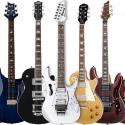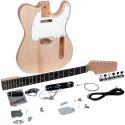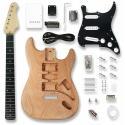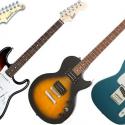Guitar Neck Shapes - What's Out There and What to Know
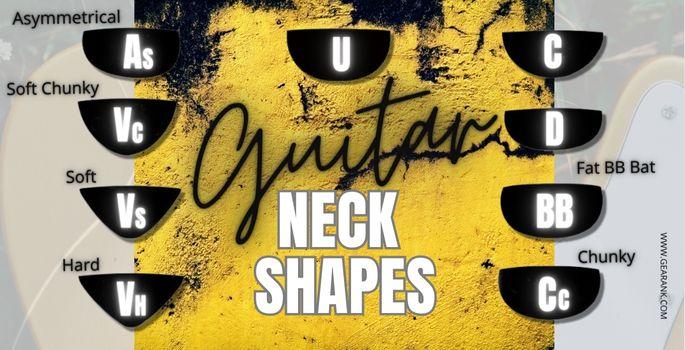
A beginner might look at several guitar neck shapes and assume they are identical. But subtle differences can impact comfort level and overall playing experience.
Most experienced musicians will have their neck shape preferences based on familiarity. The more familiar the neck feels, the less technique adjustments are needed. This results in playing comfort.
The guitar you play the most will dictate your neck shape preferences. And this is the safest pick when choosing between different neck profiles.
But to find the best guitar neck shape, you must leave your comfort zone and try other shapes. This way, you can discover which ones fit your playing style better.
Some guitarists have imprinted their muscle memory to a particular shape. They end up having a hard time playing other guitars.
I recommend regularly switching between electric and acoustic guitars so you don't get too used to just one particular feel.
What Is A Guitar Neck?
The guitar neck is the long piece of wood that holds the strings. It extends from the guitar's body and connects with the headstock.
It is the part you grip as you fret the strings. It serves as the main playing surface of a guitar. So when people talk about playing feel, it's usually about neck feel and setup.
Necks are made from different types of wood and come in different shapes and sizes. The neck's thickness, width, contour, and finish contribute to its playing feel.
Why Do Guitar Necks Have Different Shapes?
Guitars have different neck shapes because there is no standard shape. Manufacturers can design their necks based on what they think will appeal to their customer base.
Even with this freedom, neck shapes stayed within traditional designs. Most guitars have neck shapes that resemble classic Strats and Les Pauls.
But there are brands like Ibanez that push the envelope. They offer thinner neck shapes and unique contours that fit today's fast-paced playing.
What is Guitar Neck Profile
To understand your guitar neck's shape, consider the neck profile, or the cross section shape of the neck.
Neck profile pertains to the contour and shape of the back section of a guitar's neck. It describes how the neck feels as you move your hand along the back of the neck.
It considers everything, including the back curve, the thickness, and the contour changes as you go up the neck.
Curvature is the most significant factor when it comes to identifying neck shapes. And this is because curvature differences are more readily felt by the hand.
This is why neck shapes are named after the shape that your hands make while grabbing the back of the neck.
Illustrations of cross sections are used to help better visualize the different shapes.
With the visual in front of you, you can search through our descriptions below to see which shape your guitar neck fits into.
The 9 Guitar Neck Shapes Explained
Here are nine of the most common neck shapes you'll encounter in the wild.
1. C Shape Neck
The C profile neck is the most common neck shape you will find. Create the letter C with your hand, and you will have the generic grip shape of a C neck.
The C shaped neck is described as oval, and it is the most comfortable for most people.
This shape is remarkably comfy for those with large hands.
Some companies will refer to the C shape as a flat oval. This is because the fretboard radius is flat while the grip is oval.
It's a somewhat redundant statement, but the extra description gives a clearer picture.
This common shape also comes with additional descriptors, which are genuinely helpful. They include:
- Nut-Shaped
- Fat
- Slim Taper
- Extra-Slim
Slim C profiles still contain the classic C curve, but they don't come out very far away from the fretboard.
Fat C shapes are the opposite and will be at least 0.9 inches from the fretboard.
A Nut-shape neck is between slim and fat. The width will be the same size as the nuts on the guitar.
Extra-Slim is self-explanatory, meant for those who prefer thin, fast-feeling necks.
2. C Chunky Shape Neck
The C Chunky is very similar to the C shape. But the width of the grip is much larger. Most people find this size rather uncomfortable, except for large-fingered and large-handed individuals.
Because of the extra width, your fingers must reach further to touch the strings. If you have a flat palm and long fingers, the C Chunky shape is perfect.
However, you might prefer the original C shape if you have large hands but have "normal" or small fingers.
3. U Shape Neck
The U-shaped guitar neck looks very similar to the C, but the curve between the fretboard is much larger.
U profile will always be chunkier than a C, even a Chunky C.
Many people describe U-shaped necks as baseball bats. This is because the design is so wide it almost makes the entire neck feel round.
The U is the most comfortable neck shape for people with large palms and fingers.
4. BB Bat Shape Neck
The BB Bat (Baseball Bat) is a Chunky U. The name for the BB Bat first came around in 1953, much earlier than the other Chunky alternatives.
It is often found on vintage Fender Telecasters. Most people may find it challenging to use a BB Bat-shaped neck. They are best for those with large palms.
5. V Shape - Soft Neck Shape
The soft V profile is very similar to a C shape. The main difference is the narrower mid-palm shape.
The creation of the soft v-neck is an unusual story. The Fender factories accidentally made the shape as a batch of bad guitar necks.
But as the manager grabbed the neck, he realized it fit his preferred playing style perfectly. So instead of binning the entire batch, Fender turned it into a new guitar neck style.
V shapes are an excellent choice for players who prefer their thumb to hang over the fretboard instead of underneath.
The soft V doesn't have a hard point. Instead, you can expect a slight curve in the middle of the shape. This shape is found in some 50's Fender Stratocasters and the Eric Clapton Signature Stratocaster.
6. V Shape - Soft Chunky V Shape
This guitar neck shape resembles a soft V but has a bit more heft.
It is ideal for those with bigger hands and retains the narrow mid-palm soft V shape.
The chunkier feel of the neck gives your fretting hand a better grip and support. This makes bends, vibratos, milking notes, and similar techniques easier.
Many blues guitarists prefer this type of neck.
7. V Shape - Hard Neck Shape
The hard V shape neck has a more aggressive point in the middle of the grip. The hard version is rare in modern guitars but can be found in reissues or antiques.
I recommend the V shape only if you have a small palm and long fingers.
(I've only encountered this shape on a USA-made Washburn Dimebag Darrell Signature Guitar I tried out years ago. - Editor)
8. D Shape
The D profile is also called the modern flat oval.
The D shape is exceptionally comfortable and is preferred by most fast-paced guitar players. You'll find most electric guitars use the D-shape method.
D closely resembles the C shape, especially the C slim. This is because the curve is very forgiving. Your hand hugs the fretboard in an excellent tight grip.
The main point of difference is the D's flatter edge. The curve reaches its full height quicker than a C to create a naturally shallow curve.
The Ibanez Wizard neck shape (and its derivatives) is an excellent example of this neck shape.
9. Asymmetrical Shape
Asymmetrical necks are designed to follow the shape of a gripping hand better. These necks tend to be bulkier in one area of the neck than another.
The idea is to make the harder-to-reach areas of your neck easier to touch while giving the base of your palm a comfortable resting space.
Asymmetrical guitar neck shapes are less common than the others. But those who use them stand by how good the neck feels.
The EVH Wolfgang series' neck is an asymmetrical neck carve.
Which Guitar Neck Shapes Should You Choose?
Now that you know the eight common guitar neck shapes, I'll help you zoom in on what's good for you.
Some shapes are better for specific hand sizes, but if you need help determining where your fingers and palms fit on the spectrum, use this more condensed guide to help you find your way.
Large Hands
Players with large hands should choose between a U shape or a D shape neck.
U shape is less chunky than C and D, making them perfect for wide grips and short fingers. The shoulders will usually be more prominent on U-shaped necks too. This means the traditional thumb placement will be easier to achieve. Note that traditional thumb placement is at the back of the neck, as practiced in classical guitar.
Because the U shape is very similar to a typical hand shape, moving your hand up and down the neck will be smoother.
The only issue with a U is its current popularity. Most guitar neck shapes pick Ds or Cs, which means second-hand U shape necks might be hard to find.
Ds, on the other hand, are very popular. That's because the shape is chunkier for a super comfortable grip. This size is perfect for people with large palms and long fingers. You might need long fingers to reach the middle of your fretboard.
You should avoid sizes C (or Modern C) and Thin U. These may be too thin, and your fingers need more space to fret correctly. You will feel like you're holding a child's toy.
Small Hands
Small-handed players should pick a C, Modern C, or Thin U.
The Modern C profile is another name for the general C shape. However, the shoulders around the neck are hardly there. You'll have fewer materials to fight against as you try to reach your strings.
This is the best shape for small hands, because accessing the fretboard doesn't require big hands or fingers.
This is the most common among recent guitar releases. And it works well regardless of guitar playing style.
If you don't enjoy a super round shape, try a Thin U. This thin neck option can help you reach the correct thumb placement due to the naturally flat back of the U-shaped neck.
The thin neck also allows for simple sliding up and down the frets. This shape is perfect for fast-playing guitarists.
One issue many small-handed guitarists have with the Thick U neck shape is its chunkiness.
To create the thin shape while maintaining the U means the palm of your hand needs to be wide.
Wide small hands won't find this a problem, but hands that are small in all dimensions will struggle with this shape.
Secondly, Thin Us is hard to find. Some manufacturers may not have a Thin U alternative.
Small-handed players should avoid these neck shapes: D, Hard V, and regular U. Although the U Shape can benefit small-handed players, a flat back and deep chunkiness may make it less comfortable.
Left-Handed Players Vs. Right Handed Players
The guitar neck shape recommendations above apply to both right-handed and left-handed players.
However, left-handed players will have more difficulty finding unique shapes in left-handed configurations.
Use our advice above, but be aware that some will be hard to find.
Thankfully, this hasn't stopped many great left-handed guitarists from making it big in the music industry.
Guitar Neck Joints
There are three common neck joints: bolt-on, set-neck and neck through. All three affect the feel of the neck on the upper frets.
A neck through guitar will have the smoothest feel since the neck and body are parts of one continuous block of wood.
The Different Lengths Of Guitar Necks
Most guitars will have a 25.5 scale length. This is a measurement from the tip of the neck shape or the nut to the bridge where the strings are held tight.
However, although this is the standard, there are two other lengths to consider - the short-scale and the multi-scale.
1. Standard Scale Length
A standard scale length guitar will be 25.5 inches long. Most Strats, Teles, and their modern variants have this scale length.
Gibson has a different "standard scale length" of 24.75 inches long.
These scale lengths usually come with 22 frets and reasonable spacing to accommodate small and large fingers.
2. Short Scale Length
Short-scale lengths are closer to 24 inches. This means shorter fret space for easier access.
But on the flip side, it makes it hard for larger fingers to fit into the frets.
A shorter scale length also means less string tension. These looser strings feel easier to fret, ideal for beginners and students. They are also great for using advanced techniques.
Another downside to lower string tension is being prone to fret buzz and other fret noises when not set up correctly with the correct string gauge.
Guitars with short necks (short scale length) are generally not suitable for guitarists with large hands.
3. Multi-Scale Length
Multi-scale length guitars incorporate scale more accurately, resulting in fanned frets at an angle.
The fanning technique allows more frets onto the neck and more precise scale intonation.
But this also means technique adjustments for the guitar player. Playing fanned fret guitars have a steep learning curve. It's not recommended for beginners and students.
But those who master multi-scale length necks enjoy increased sonic accuracy and allow for interesting note combinations that aren't ordinarily available in guitars with standard frets.
These guitars are around 25.5 inches long and 27 inches long. The 27 inches can accommodate heavier string gauges.
Because of their unique design, guitars with fanned frets are usually more expensive. Neck shape choices will also be limited to modern slim taper types.
This is for you if you're into virtuoso-level playing and want to stay within the norm.
How To Maintain Your Guitar Neck
Necks are prone to damage and deformity, much like any wooden item. So regardless of shape, your guitar neck needs proper care.
1. Deep Cleaning the Fretboard
Over time, your fretboard will be covered in dirt, dust, and oils. So whenever you change the strings, take the time to clean the fretboard.
Cleaning the fretboard will prevent rust over the metal frets or mold over the wood.
A dry clean cloth is usually enough. But for persistent grime, you may need a damp cloth or a soft-bristled toothbrush with soapy water.
Note that different fretboards may require other cleaning methods.
Best to check with your manufacturer for your guitar's specific needs.
2. Clean Your Fretboard Daily
The cleaning method above is for a deep clean, but you should clean your strings and fretboard every time you use it to prevent significant build-up.
Grab a clean cloth, wrap it around a string, and then pull the fabric across the strings. Go up and down the fretboard to cover the entire length of the strings.
You can also use paper and string cleaners to clean faster and more efficiently.
The main point is to regularly clean the strings and frets to prevent dirt, oil, and grime build-up.
3. Keep Your Guitar Away From Hot Places
Humidity can warp your guitar's wooden neck.
Humidity can change along with the season. Ensure you know humidity levels and use a de-humidifier as needed.
A good humidifier inside the guitar case can give your instrument balanced humidity levels within the case.
The neck should not be exposed to too much heat, sunlight, and water. Following this basic instruction will save you from many maintenance-related heartaches and expenses.
Too much heat and water can deform wood, resulting in cracks and deformities that may render the neck broken or unplayable.
So avoid giving your guitar prolonged exposure to extreme conditions.
4. Keep Your Guitar Away From Freezing Temperatures
Extreme cold temperatures can harm your guitar too. It can tighten the wood or cause water fragments to crack through the structure.
As a rule of thumb, you should keep your guitar at around 65 to 77 degrees Fahrenheit (18 to 25 degrees Celsius) and 50% humidity.
If you live in an area with rapidly changing temperatures, consider buying a temperature control unit for your storage rooms. Alternatively (and the more affordable option), consider buying a secure lock case. This will prevent hot air entering the case or water vapor from seeping into the woodwork.
5. Guitar Check Up
You should hire a professional to check your guitar if you play often. They can check neck alignment, String Action, fret life, intonation, etc. And they can do quick fixes too.
A good technician can also help you better care for your instrument, which is crucial if you want to keep your precious guitar in good shape.
6. Use A Guitar Stand
Never lean your guitar on an amp or wall. This will put more pressure on the neck, which may cause warping. Or worse, your guitar may fall to the side.
Instead, use a guitar stand; it provides neck support and a more stable display position.
Guitar stands are also a great way to display your prized possession when not in use.
Being able to reach for your guitar quickly also encourages more play and practice.
Frequently Asked Questions:
What Guitar Neck Shape is the Best?
There are only a few ideal neck shapes because everyone's hands differ. The most common neck shapes are U, C, and D shapes. It's best to stick with the most comfortable shape. But it also helps to switch to other shapes occasionally to loosen up your fretting hand.
What's the Difference between D Shape Neck and C Shape Neck?
They are very similar, but a D shape has a flatter back while a C shape is rounder. C shapes are more comfortable, while D shapes allow faster playing.
Remember that advice changes based on your hand size.
What is the Easiest Guitar Neck to Play?
The easiest neck is supposed to be the one that suits your hand size well. But most of the time, the easiest neck is similar to the guitar we're most used to playing.
Does Guitar Neck Shape Matter?
The shape of your guitar neck will determine how comfortable you are at playing guitar. An incompatible shape can make playing tedious and uninspired.
Final Thoughts
Now you can better recognize different neck shapes. And you know that their names refer to the shape that your hand makes while grabbing the back of the neck.
You have two options: stick with the familiar and comfortable shape, or try other shapes to see if they fit you better.
As I mentioned earlier, I recommend regularly switching between different guitars. This way, you can play comfortably on guitars of different neck shapes.
If you find this Guitar Neck Shapes article helpful, you'll also love reading our Guide to Cleaning a Guitar.




